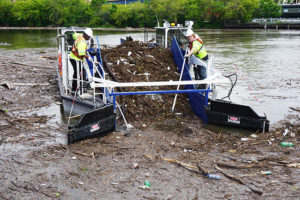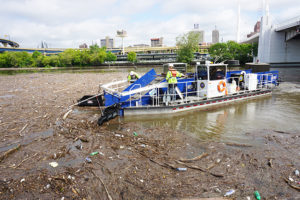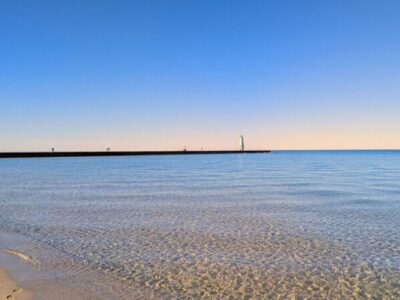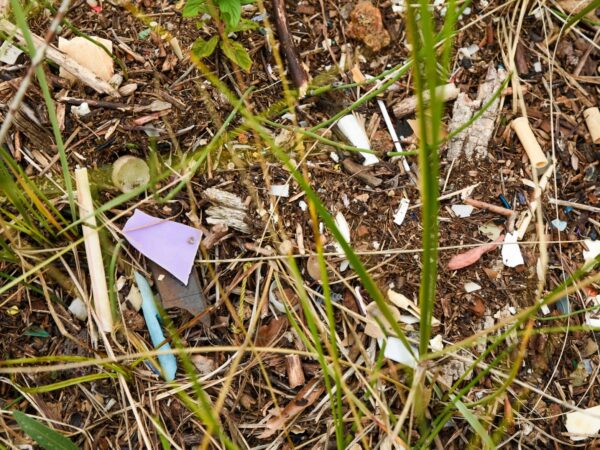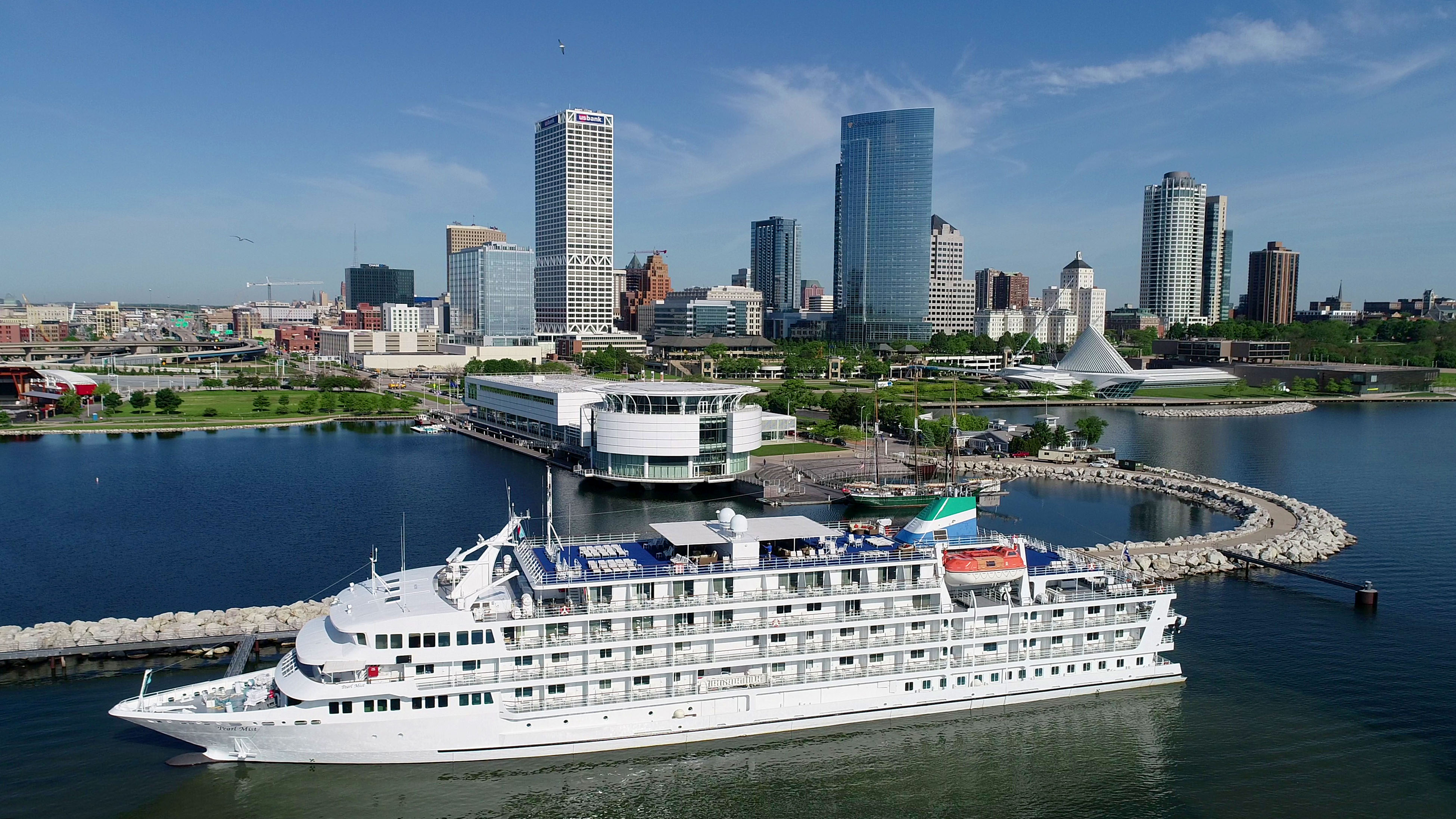
In 2012, an environmental star of sorts was born, celebrated by Milwaukeeans, especially those who enjoy strolling along the Milwaukee Riverwalk or kayaking on Milwaukee River.
The Lynyrd Skymmr is a 50-foot-long river skimmer that cruises Port Milwaukee‘s waterways several times a week to collect floating debris — dead fish, plastic bottles, branches and other refuse.
However, when it comes to Port Milwaukee’s attempts to clean up the river, Lynyrd Skymmr only touches the surface of its efforts. The bulk of the work happens underground.
The Milwaukee Metropolitan Sewerage District contracts the services of Lynyrd Skymmr and also operates greater Milwaukee’s wastewater treatment, flood management and green infrastructure for the area’s 28 communities with 1.1 million residents. Managed by a commission of 11 elected and appointed officials, the district is the recipient of multiple U.S. Water Prizes for administering clean-water programs and infrastructure improvements.
“(Port Milwaukee) directly supports the Skymmr’s operations as it takes care of significant visible debris and pollution in the waterways,” Port Milwaukee Director Adam Schlicht said in an email. “Other factors that can degrade water quality – including surface and sewer runoff – have been substantially addressed by the Port, MMSD, and other City of Milwaukee departments in recent decades, so much so, that there has been a booming interest in water recreation throughout Milwaukee. You can see it in the number of kayaks and other recreational vessels, in the popularity of the river walks, the competitive rowing, fishing, and other nature-focused activity.”
Schlicht said his chief role is realizing Mayor Tom Barrett’s vision for improved connectivity of the city’s waterways and making Milwaukee “the centerpiece of our nation’s ‘Fresh Coast.'”
Each year since 1994, the district has exceeded the national goal set by the Clean Water Act (CWA) of removing 85 percent of raw waste during sewer wastewater treatment.
“Since 1994, we’ve captured and cleaned 98.4 percent of every drop of water that’s gotten into the sewer system,” said Bill Graffin, Milwaukee Metropolitan Sewerage District’s public information manager.
“The 28 communities we serve all own and operate their own sewer systems. These connect to regional systems in the ground,” Graffin said, adding the main district system amounts to 300 miles of infrastructure, which connects to community infrastructure supporting another 3,000 miles of private lateral lines.
Because one inch of rainwater soaks the district with 7.1 billion gallons of water, the district operates a private-property management program to assist residents in evaluating and updating their underground infrastructure.
“Unfortunately, we don’t drive through the underground infrastructure every day. We don’t see the wear and tear,” Graffin said.
The MMSD also promotes the development of green infrastructure to “manage water where it falls,” such as rain gardens, bioswales, porous pavement and stormwater trees, which are among several efforts that boosted Milwaukee to the status of national leader in clean-water management.
Graffin explained the Milwaukee Water Pollution Abatement Program launched in 1977 spawned today’s clean water initiatives. The program was the city of Milwaukee’s response to a 1972 U.S. Supreme Court decision in a 1969 public nuisance lawsuit brought against the city by the state of Illinois. The court ruled that nuisance complaints can apply to water quality issues. In 1977, Federal District Court ruled the city must modify its sewer system for improved water quality, including the elimination of its Combined Sewer Overflow (CSO) system by 1989.
Kevin Shafer, the executive director of the MMSD, talked to Great Lakes Now earlier this year and brought up his goal of zero sewage overflows to the lake by 2035.
Milwaukee isn’t the only Great Lakes city to adopt innovative methods of keeping water clean and managing sewage and stormwater. Buffalo, New York; Racine, Wisconsin; and Cleveland, Ohio, are just three other cities in the region that have installed green infrastructure such as bioretention basins and rain gardens.
“We used to have 50 to 60 overflows a year, which was eight to nine billion gallons. Now we have one to two overflow events per year,” Graffin said.
According to Graffin, the district invested more than $4 billion in expanding and improving Milwaukee’s two water treatment plants and regional sewer system and constructing a deep-tunnel overflow system. Another $1.6 billion is slated for continued clean-water initiatives over the next six years.
Featured Image: A cruise ship in Milwaukee’s harbor. Photo by Milwaukee Journal Sentinel, Courtesy of Port Milwaukee
3 Comments
-
Why isn’t the Lynyrd Skymmr out skimming now. Lots of debris in the water…
-
This is incredible counsel! Exceptionally legit and useful. I truly partook in this post. Pleasant post!! these tips might help Great post, Jo! My number one work advice.Thanks such a great amount for a point-by-point post! It is exceptionally useful. Your post is useful to keep away from botches.
-
The rivers, lakes, groundwater and lands in the Milwaukee River basin sustain a wide range of plant and animal life. Located in portions of seven counties, contains 13 cities, 32 towns, 24 villages and is home to about 1.3 million people.


